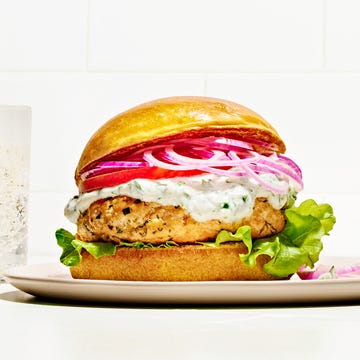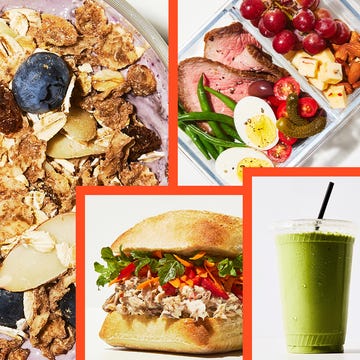SPEND ANY AMOUNT of time on the muscle-building corners of social media and you’ll start to wonder, Why do all these people eat the exact same thing?
You know the meal I’m talking about: chicken, broccoli, carb. I say “carb” because sometimes that carb is rice, sometimes it’s a sweet potato, oatmeal, or quinoa.
This chicken-broccoli-carb trio is founded in smart nutritional science. Protein does build muscle. Broccoli is nutrient-dense vegetables. And rice, sweet potatoes, oatmeal, and other grains are all great sources of carbohydrates and additional nutrients.
But what bothers me as a dietitian is that this meal is no better than building muscle than any other meal of the same makeup—particularly meals that incorporate ingredients and flavors from other parts of the world.
In short, the chicken-broccoli-carb is a white-washed, Euro-centric approached to building muscle.
And I’m not alone in thinking so.
According to Maya Feller, MS, RD, CDN, author of Eating from Our Roots healthy diet is more than one-size-fits-all.
“I find it problematic when the social media recommendations suggest that everyone needs 150 grams of protein each day, coming from chicken breast, liver, and protein powder only,” Feller says. “Or, that we be relegated to steamed broccoli and grilled chicken for the rest of eternity. We can and should include flavor, spice, a variety of grains, legumes, and vegetables, as well as plant and animal proteins that are accessible and culturally relevant.”
When we don’t acknowledge that "healthy" food also includes foods from other cultures—or we say that one specific meal is superior to gaining muscle over all others—we’re failing to reach a huge part of the population with whom we can potentially engage. This keeps us stuck in an antiquated, unhelpful space.
I see this myself through my work with clients: A lot of people want to talk about “healthy” food with me. What’s “healthy” depends on who you ask. As it turns out, what “healthy” looks like is based not only on science, but also on how and where you were raised, and what your values are.
What also doesn’t help: Some influencers portray certain proteins or carbohydrates as evil. This tends to happen with white rice, pasta, and soy. These foods are eaten daily in many other countries, yet are often portrayed by wellness influencers as being “toxic” or “inflammatory.”
We also often see fitness influencers demonizing beans and lentils, two foods eaten in high quantities throughout the world, because of their lectin content. The truth: Lectins are a defense mechanism in plants also described as an "anti-nutrient," even though they are largely denatured with cooking and well-tolerated by the majority of people.
If your focus is on protein for muscle building, plant-based proteins like soy and beans are high-quality, nutritious, and cost-effective.
And then there’s the whole issue of affordability. Rice, tofu, and legumes, for example, are often more cost-effective than meat. Canned or dried beans give you a ton of protein and fiber for a fraction of the cost of meat.
That doesn’t stop shirtless influencers shouting in grocery stores about how we should never eat plant foods because they’re so toxic.
Look, just over 40 percent of the U.S. population identifies as something other than white. That’s a lot of people who may eat non-Eurocentric foods as part of their normal diets. What are the health and fitness industries saying to them?
Most likely, nothing.
But there is some progress being made, at least on the federal level.
The most recent rendition of the Scientific Report of 2025 Dietary Guidelines Advisory Committee, which is the draft version of the next update to the Dietary Guidelines for Americans, has taken the step of making their recommendations more culturally inclusive.
The report states this:
The U.S. population has become more racially and ethnically diverse…during the past decade, highlighting the need to ensure that the Dietary Guidelines for Americans are representative of the country’s diverse populations and their various nutritional needs and cultural preferences…
Different cultures have varied understandings of what constitutes a healthy diet based on their traditional knowledge, historical food practices, and external factors such as globalization, migration, and cultural exchange that impact groups as they transition across contexts. Nutrient-dense foods that align with the dietary patterns recommended by the Dietary Guidelines for Americans are present in all cultural diets, and a goal of culturally responsive dietary interventions is to identify and recognize such foods and how their preparation may promote health.
Dietitian Christy Wilson agrees with these proposed changes to the DGAs for 2025-2030.
“The language used in the most recent guidelines allows for the inclusion of foods that respect and honor people's cultural traditions that previous versions seemed to minimize or even ignore,” Wilson says.
"Our world is multicultural, and we must be respectful of the foods other people eat and adapt our recommendations as such. As a dietitian who has long served multicultural communities, it's nice to see the Dietary Guidelines of America using language that encourages, and doesn’t demonize, diversity on our plates.”
Government guidelines are only one piece of the puzzle, and not one that’s in most people’s line of vision. That distinction belongs to the digital world.
Research shows that a varied, mostly whole-food diet that’s heavy on plants seems to lower risk for all-cause mortality and diabetes. It’s considered to be the gold standard for gut health and maintaining weight loss over time.
Having a more inclusive attitude towards what constitutes a "healthy diet," while eating a wide variety of food, is a great way to diversify your nutrient intake and—increase cultural awareness.

Abby Langer, RD is the owner of Abby Langer Nutrition, a Toronto-based nutrition consulting and communications company.













